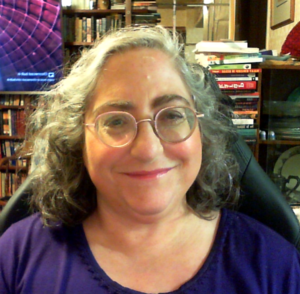Part Three
The recipes in The Wizardry of Jewish Women are Jewish food, but not as most people know it.
In the novel, two sisters (Judith and Belinda) are sent boxes that were stored in a garage for two generations. One box is full of culinary recipes from their great-grandmother Ada. The other box is also full of recipes, but for spells.
Belinda, the cook, takes the box with the recipes. She sends food parcels to Judith as she tests the recipes. In one of the parcels is feminist biscuits, because Belinda believes profoundly in teasing her feminist sister. The recipe box was terribly important. I wanted to show readers that lost culture could be fascinating and familiar. Also, I wanted to balance magic with memory.
Ada’s recipes are mostly from Belle Polack, my grandmother, because Ada and Belle are from near-identical cultural backgrounds. Jewish cooking followed a really interesting historical path from London to Australia and that is the path I used for Ada’s recipes.
Now for some recipes. First, the feminist biscuits (which would probably be called “˜cookies’ in North America) and then, some of my grandmother’s recipes.
Anglo-Jewish Australian cooking has some significant differences to other Jewish foodways. Ask me sometime, because this is one of my favourite subjects. I often start by saying something like, “My people cook, but we have no family bagel recipe.” The family lost many recipes for a generation. Only my first cousin believed we had family recipes for Christmas until my grandmother’s notebook was found hidden in my father’s study after he died.
The only metric recipe is the one for feminist biscuits, because it’s the only modern recipe. All the other recipes use British Imperial measurements. The cups are pre-metric Australian cups: a cup of sugar is 6 ounces and one of flour is 4 ounces. Here is a conversion tool for some of the rest.
I admit, I use a table at the back of a 1970s cookbook when my memory fails me, or I do conversion using my family’s classic “By guess and by G-d” technique. Â Â
Feminist Biscuits
Ingredients
- 150 g butter or equivalent amount of oil
- 1 large egg
- 1 small cup sugar
- 1 cup self raising flour
- 1 drop vanilla (optional)
- Desiccated coconut
- Green food colouring
- Purple food colouring (red and blue combined) Â
Method
Melt butter. Add everything except the food colouring. Mix well. Swirl the food colouring through the mix. Drop a teaspoon at a time on well-greased trays. Bake in a moderate oven for 10-15 minutes. Try not to eat them all at once. Â
Christmas Pudding
This is my grandmother’s recipe, transcribed. I haven’t modernised it or translated it at all. I did, however, add a comma. Note: Do not even think of making the milk variant of this Jewish Christmas pudding for anyone who keeps kosher. Â
(Medium Rich) 1 lb suet, ¾ lb fine breadcrumbs, ¾ lb brown sugar, ¼ lb flour, 1 lb sultanas, 1 lb currants, ¼ lb mixed peel, ½ teaspoon mixed spice, a good pinch salt, 1 lemon, 4 eggs, ½ pt beer or milk, ½ gill brandy. Prepare all the ingredients. Sieve flour & mix with crumbs & finely chopped suet. Add fruit & chopped peel & grated rind of lemon & sugar. Mix in the beaten eggs, beer or milk. Stir well. Cover a clean & put away until next day. Add the brandy, turn into greased basins & cover with the greased paper & pudding cloths. Boil for 8 to 10 hrs. Remove the paper & cloths, let puddings cool & recover with fresh paper & dry cloths. Store in a cook, dry place. Boil for a further 2 hrs before serving. Â
And now for a few more less contentious recipes. Â
Belle Polack’s Honey Cake for Jewish New Year Â
Ingredients
- 1 lb honey
- 1 ¼ cups plain flour
- 1 small cup sugar
- 2 eggs
- 1 small cup oil or melted butter
- 1 tsp cocoa
- 1 tsp mixed spice
- 1 tsp cinnamon
- a heaped tsp bicarbonate of soda Â
Method
Melt the honey and sugar over a low flame. When they are cold, add the eggs (which should be well-beaten first””a form of domestic discipline), the oil and the remaining ingredients. Put the bicarbonate of soda in last.
Pour into a well-greased cake tin and bake in a moderate oven for 1 ½ hours.  Â
Madeira Cake Â
This cake is from Belle’s maternal grandmother who left London in the 1860s. Â
Ingredients
- 5 oz butter
- 6 oz sugar
- 6 oz self raising flour
- 2 oz plain flour
- 2 eggs
- ½-1 cup milk
- 1 tsp vanilla Â
Method
Cream butter. Add vanilla. Beat in eggs well, one at a time. Add flour then milk and vanilla. Bake for 1 ½ hours in a moderate oven.
 BIO: Dr Gillian Polack is a Jewish-Australian science fiction and fantasy writer, researcher and editor and is the winner of the 2020 A Bertram Chandler Award. The Green Children Help Out is her newest novel. The Year of the Fruit Cake won the 2020 Ditmar for best novel and was shortlisted for best SF novel in the Aurealis Awards. She wrote the first Australian Jewish fantasy novel (The Wizardry of Jewish Women). Gillian is a Medievalist/ethnohistorian, currently working on how novels transmit culture. Her work on how writers use history in their fiction (History and Fiction) was shortlisted for the William Atheling Jr Award for Criticism or Review.
BIO: Dr Gillian Polack is a Jewish-Australian science fiction and fantasy writer, researcher and editor and is the winner of the 2020 A Bertram Chandler Award. The Green Children Help Out is her newest novel. The Year of the Fruit Cake won the 2020 Ditmar for best novel and was shortlisted for best SF novel in the Aurealis Awards. She wrote the first Australian Jewish fantasy novel (The Wizardry of Jewish Women). Gillian is a Medievalist/ethnohistorian, currently working on how novels transmit culture. Her work on how writers use history in their fiction (History and Fiction) was shortlisted for the William Atheling Jr Award for Criticism or Review.
If you’re an author or other fantasy and science fiction creative, and want to do a guest blog post, please check out the guest blog post guidelines. Or if you’re looking for community from other F&SF writers, sign up for the Rambo Academy for Wayward Writers Critclub!





 I’m not the world’s best cook by any means. If given the option, to steal more time for writing I will order in or use prepackaged dinners. But there are things I make when I need that extra comfort that take-out or microwave meals won’t provide. It was no surprise that one of my favorite home-made meals made its way into my novel Chaos Wolf.
I’m not the world’s best cook by any means. If given the option, to steal more time for writing I will order in or use prepackaged dinners. But there are things I make when I need that extra comfort that take-out or microwave meals won’t provide. It was no surprise that one of my favorite home-made meals made its way into my novel Chaos Wolf. About the Author: Sheryl R. Hayes can be found untangling plot threads or the yarn her cats have been playing with. In addition to writing, she is a cosplayer focusing on knit and crochet costumes and works full time at a Bay Area water company. You can follow her at
About the Author: Sheryl R. Hayes can be found untangling plot threads or the yarn her cats have been playing with. In addition to writing, she is a cosplayer focusing on knit and crochet costumes and works full time at a Bay Area water company. You can follow her at  He gestured toward the couch. “Would you like tea, coffee, or soda?”
He gestured toward the couch. “Would you like tea, coffee, or soda?”